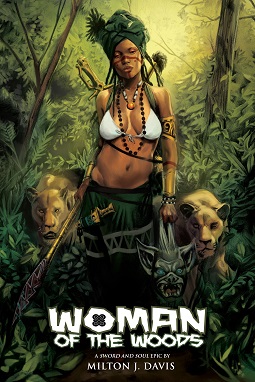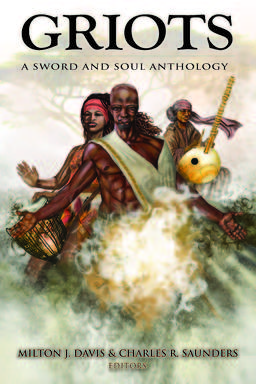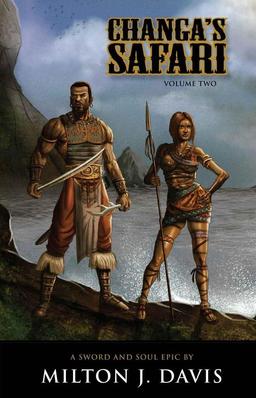A Look Into the Heart of the Great Continent: Milt Davis’ Woman of the Woods
 Sword and Soul is a genre that embraces the pulp-style action and adventure of Sword and Sorcery with the world-building of Heroic and Epic Fantasy.
Sword and Soul is a genre that embraces the pulp-style action and adventure of Sword and Sorcery with the world-building of Heroic and Epic Fantasy.
It was born in the 1970s, when famed author Charles Saunders created Imaro, the first black fantasy hero in Sword and Sorcery fiction. Using the diverse mythologies, religions, histories, and traditions of Africa and its many ancient cultures, Sword and Soul offers us a look into the heart of that great continent and the rich heritage of its people. The setting is often an alternate-world version or a forgotten age of prehistoric Africa, something that is often ignored in fantastic fiction, other than those tales of “the great white hunter in Darkest Africa.”
The beauty of Sword and Soul — what makes it unique and refreshing for me — is that it revolves around a world, its people and cultures and traditions, that are not usually represented in the medieval, European-based worlds of fantasy.
Milton J. Davis (author of Changa’s Safari, Meji, and co-editor, along with Charles Saunders, of the anthologies Griots and the upcoming Griots 2: Sisters of the Spear) is at the forefront of the new Sword and Soul movement, leading a wave of new authors who are building new worlds and expanding on old concepts and traditions.
In Woman of the Woods, Davis returns to the world of Meji and introduces us to a new character, Sadatina. She’s a young Adamu girl on the threshold of womanhood, who finds herself at the center of a war between her people and their old enemy, the Mosele. For all the action, adventure, and magic, this is also a dramatic “coming of age” story, with real flesh and blood characters that have a past and carry the emotional weight and baggage everyone collects over the years.
The Prologue opens with Sadatina ba Hazeeta telling her grandchildren the story of her life and how her birth took place at a time when their people, the Wangara, were preparing for war against the Mosele, who worshipped the god Karan.
 The next part, Book 1, is a short opening to the main story and takes place just before the birth of Sadatina. This section of the chapter tells us of Ichecha Sama of the Wangara, a High Priest of Djenna, who receives a message from the god Cha concerning the coming of the Mosele.
The next part, Book 1, is a short opening to the main story and takes place just before the birth of Sadatina. This section of the chapter tells us of Ichecha Sama of the Wangara, a High Priest of Djenna, who receives a message from the god Cha concerning the coming of the Mosele.
We then cut to Hazeeta, a shosa of the Wangara — a holy warrior whose life is dedicated to her land and her people and their god, Cha. She has given birth to a daughter, in defiance of the edict that a shosa is forbidden to marry or have children; a child born of a shosa is always killed and the mother punished for breaking this law. But Hazeeta loves her daughter and gives her to an Adamu family, who will love and raise the baby as if she were their own. I don’t think I’m giving anything away here by telling you that the baby grows up to be Sadatina.
At the age of 13, Sadatina’s foster parents discuss the idea of arranging a marriage for her. But Sadatina would rather hunt and go her own way, lead her own life. Baba, Sadatina’s father, hires Teshome, a river man from the village of Kasamba, to help out on the family farm. Baba thinks Teshome would make a fine husband for his daughter. Sadatina then beats Teshome at wrestling, and while they have those moments where you’re not sure where their relationship is heading, they gradually become friends.
While hunting in the woods one day, Sadatina kills a shumba, a lioness, and then discovers the two cubs that were left behind with no mother to care for them. Feeling sorry for the cubs, Sadatina decides to care for them, hunting and raising them as if they were her own children.
A bond forms between them and she teaches the cubs — whom she names Pausa and Nokofa — how to hunt with her. As time passes and the cubs grow up, Sadatina finally decides to marry Teshome.
Sadly, her life soon turns upside-down when her adoptive family is slain by the terrible nyokas — demonic creatures who aid the Mosele — the old enemy of her people who are once again on the march to war. She finds her father, barely alive, who tells her, “You are your mother’s child,” before dying in her arms.
Sadatina buries her family and then calls Pausa and Nokofa, the shumba cubs, to her side. “Come, sisters,” she says. “We’re going hunting.” Later, Sadatina decides to live in the forest and soon becomes the guardian of her village. Her people give her the name, Woman of the Woods.
The story jumps to some years later and returns us to the lands of the Wangara and to Hazeeta the Shosa, who still thinks of the child she gave away so long ago. The Mosele, the children of the god Karan, are waging war again, and Hazeeta and her sister warriors head back to the village where she had left her child, Sadatina, in the care of Baba and his wife. When they arrive, they discover the graves of Sadatina’s foster family and so begin their search for Sadatina.
 This leads us to the heart of the story, jumping perhaps a bit too quickly to some years later, with Sadatina now a grown woman and a great warrior. While I would have enjoyed reading more of Sadatina’s life in the woods, before reaching her majority and becoming a warrior of the Shosa, before her reunion with Hazeeta and Teshome, I was not put off by the quick leap forward in time.
This leads us to the heart of the story, jumping perhaps a bit too quickly to some years later, with Sadatina now a grown woman and a great warrior. While I would have enjoyed reading more of Sadatina’s life in the woods, before reaching her majority and becoming a warrior of the Shosa, before her reunion with Hazeeta and Teshome, I was not put off by the quick leap forward in time.
Milton J. Davis has once again given us a very convincing world, with cultures and traditions, religions and histories more common to Epic Fantasy than old-school Sword and Sorcery. This is where Sword and Soul bridges the two genres — in world-building. As he’s done in his other novels, he creates great characters we come to know and care about and gives us a story of some depth and meaning, a thoughtful, many-layered story.
His prose is lean, unpretentious, and well serves his purpose — which is to move the story along, set the tone, and present his world to us fully realized, in the best style of pulp fiction. I like that his dialogue is not formal (except when it needs to be) or stilted like so many of the fantasy novels I read, which tend to sound like bad Cecil B. de Mille epics.
Too many writers, in my opinion, strive for that Biblical tone, that Shakespearian touch which far too often hampers the narrative drive of a story. I prefer a more natural, modern approach to dialogue. I’m not a fan of dialogue that reads more like a speech, a lecture, instead of everyday conversation. After all, I’m certain most people “in past ages” spoke a more common language, a slang not spoken by aristocrats, clergy, and those who were more learned and scholarly.
The book itself is nicely presented, with a lush and gorgeous cover by Chase Conley, wonderful maps of Davis’s worlds, Adamusola and Uhuru, by Christopher Miller, and all nicely designed by Uraeus. I’m not too bothered by the formatting problems, which is something that seems to plague most self-published novels I’ve read, and even some small press books. This is something I’ve learned to live with, to skim over, as I do with the “he said” and “she said” used and sometimes overused in the dialogue in all novels. It does not hamper my reading nor detract from my enjoyment of a book, though I do hope that such problems are soon rectified to the benefit of all self-published authors.
If you’re looking for fantasy with a difference, I recommend that you give Sword and Soul a try, and Woman of the Woods in particular.
Sounds great and I can’t wait to check it out. That’s one of the best covers I’ve seen in some time.